:max_bytes(150000):strip_icc():format(webp)/tropical-beach-wallpaper-beach-backgrounds-587fbb765f9b584db3241860.jpg)
New Final Cut Pro Tutorial Adding Picture-in-Picture Effects to Your Videos for 2024

Final Cut Pro Tutorial: Adding Picture-in-Picture Effects to Your Videos
How to Create a Picture-in-Picture Effect Using Final Cut Pro

Benjamin Arango
Mar 27, 2024• Proven solutions
Sometimes we need to show two videos together on the same screen to convey certain usage information. If you are searching for a tool to make this task possible then Final Cut Pro is the best choice for you.
This tool can help you to use the picture-in-picture effect with ease. However, the process for adding this effect cannot be completed within one r two steps.
The article below contains complete details about how to add PIP effects using Final Cut Pro. You will be glad to know that FCP also works with few integrated plugins that assist in the free picture in picture effect generation.
How to Create PIP Effect with FCP
If you are ready with two videos and now want to bring them to the same screen then prefer to follow these simple steps:
Step 1: Add Background video
The very first step that you need to follow for PIP effect generation using FCP is to bring your main or background video to the timeline as a primary storyline. Once you have created the primary storyline then all videos for the PIP effect will be added to it.
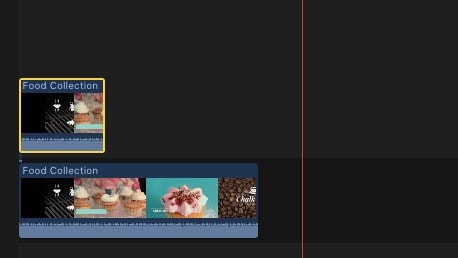
Step 2: Add PIP videos
It is time to choose the higher video clip so that the PIP effect can be applied. This task can be done either by using on-screen type controls available on the viewer or you can move ahead with transform controls available on the inspector.
Note that lower clips use to stay in the background in final results whereas upper clips will appear in the foreground. By default, both clips use to have 100% full screen with 100% opaque settings.
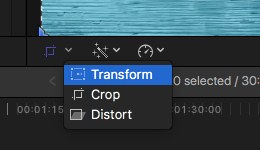
Step 3: Apply PIP effect
As now you have added both videos on-screen now you have to select the higher video and then click over the rectangular transform button that is available on the lower-left corner of viewer screen. As soon as you make this selection, the icon will turn into blue color, and naturally 8 dots will appear around the selected image or video. Use any one of these dots for scaling your selection in asymmetrical order.

Step 4: Adjust PIP Effect
- If you want to scale this image in a symmetrical fashion then simply drag the dot to the corner from the central position.
- Now hold the option key and drag one dot to the corner. It will help you to shrink as well as to enlarge the image even without affecting its actual aspect ratio.
- Users can keep on scaling this foreground image till the time they achieve essential size.
- Now click inside your selected image and start dragging it to reach a certain specific position. You can place it anywhere on a big screen.
Step 5: Follow precise Adjustment
Simply select the top clip and then hit Command + 4 to open the inspector. Now click on that blue show button over your FCP screen and it will provide you complete information about the transform category of available built-in effects. If you use inspector for this task then it can help you to get very precise results for scaling needs. It assists users to manage images with accurate position and size.

Step 6: Apply Cross- Dissolve
- Now choose the leading edge of effect and use Command + T. It will immediately apply the default cross-dissolve option for starting clip.
- You will be glad to know that the PIP effect does not restrict users to work just upon a single image rather it can be used to process as many pictures as your project needs and that can fit inside the frame.
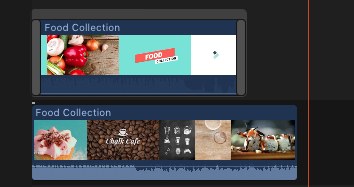
Check this video tutorial to know more details:
Picture in Picture Plug-ins for Final Cut Pro
There are so many plug-ins available in the market for Final Cut Pro platform and all of them possess unique qualities along with impressive toolsets. No matter whether you are a beginner with the PIP effect or professional making high-end video projects, FCP plug-ins can make your task much easier with their intuitive controls.
1. Tokyo PiPintor
PiPintor Free is a specially designed picture-in-picture plugin that assists beginners with easy processing of the PIP effect over Final Cut Pro platform. It simply awakes the menu-driven animation power on your tool so that picture in picture effect can be completed without key-framing.
2. ProPIP
Those who need to enjoy a higher level of customizations are advised to work over ProPIP environment. This advanced tool assists users to showcase their abilities with full freedom for personalization.
ProPIP is the best choice for newscasting, commentaries, and many other applications. It helps in generating fine controls for initial as well as end position, rotation, and scaling effects along with easy-to-use media controls over the screen. ProPIP also provides personalized borders with endless opportunities to develop impressive projects on Final Cut Pro platform.

Benjamin Arango
Benjamin Arango is a writer and a lover of all things video.
Follow @Benjamin Arango
Benjamin Arango
Mar 27, 2024• Proven solutions
Sometimes we need to show two videos together on the same screen to convey certain usage information. If you are searching for a tool to make this task possible then Final Cut Pro is the best choice for you.
This tool can help you to use the picture-in-picture effect with ease. However, the process for adding this effect cannot be completed within one r two steps.
The article below contains complete details about how to add PIP effects using Final Cut Pro. You will be glad to know that FCP also works with few integrated plugins that assist in the free picture in picture effect generation.
How to Create PIP Effect with FCP
If you are ready with two videos and now want to bring them to the same screen then prefer to follow these simple steps:
Step 1: Add Background video
The very first step that you need to follow for PIP effect generation using FCP is to bring your main or background video to the timeline as a primary storyline. Once you have created the primary storyline then all videos for the PIP effect will be added to it.

Step 2: Add PIP videos
It is time to choose the higher video clip so that the PIP effect can be applied. This task can be done either by using on-screen type controls available on the viewer or you can move ahead with transform controls available on the inspector.
Note that lower clips use to stay in the background in final results whereas upper clips will appear in the foreground. By default, both clips use to have 100% full screen with 100% opaque settings.

Step 3: Apply PIP effect
As now you have added both videos on-screen now you have to select the higher video and then click over the rectangular transform button that is available on the lower-left corner of viewer screen. As soon as you make this selection, the icon will turn into blue color, and naturally 8 dots will appear around the selected image or video. Use any one of these dots for scaling your selection in asymmetrical order.

Step 4: Adjust PIP Effect
- If you want to scale this image in a symmetrical fashion then simply drag the dot to the corner from the central position.
- Now hold the option key and drag one dot to the corner. It will help you to shrink as well as to enlarge the image even without affecting its actual aspect ratio.
- Users can keep on scaling this foreground image till the time they achieve essential size.
- Now click inside your selected image and start dragging it to reach a certain specific position. You can place it anywhere on a big screen.
Step 5: Follow precise Adjustment
Simply select the top clip and then hit Command + 4 to open the inspector. Now click on that blue show button over your FCP screen and it will provide you complete information about the transform category of available built-in effects. If you use inspector for this task then it can help you to get very precise results for scaling needs. It assists users to manage images with accurate position and size.

Step 6: Apply Cross- Dissolve
- Now choose the leading edge of effect and use Command + T. It will immediately apply the default cross-dissolve option for starting clip.
- You will be glad to know that the PIP effect does not restrict users to work just upon a single image rather it can be used to process as many pictures as your project needs and that can fit inside the frame.

Check this video tutorial to know more details:
Picture in Picture Plug-ins for Final Cut Pro
There are so many plug-ins available in the market for Final Cut Pro platform and all of them possess unique qualities along with impressive toolsets. No matter whether you are a beginner with the PIP effect or professional making high-end video projects, FCP plug-ins can make your task much easier with their intuitive controls.
1. Tokyo PiPintor
PiPintor Free is a specially designed picture-in-picture plugin that assists beginners with easy processing of the PIP effect over Final Cut Pro platform. It simply awakes the menu-driven animation power on your tool so that picture in picture effect can be completed without key-framing.
2. ProPIP
Those who need to enjoy a higher level of customizations are advised to work over ProPIP environment. This advanced tool assists users to showcase their abilities with full freedom for personalization.
ProPIP is the best choice for newscasting, commentaries, and many other applications. It helps in generating fine controls for initial as well as end position, rotation, and scaling effects along with easy-to-use media controls over the screen. ProPIP also provides personalized borders with endless opportunities to develop impressive projects on Final Cut Pro platform.

Benjamin Arango
Benjamin Arango is a writer and a lover of all things video.
Follow @Benjamin Arango
Benjamin Arango
Mar 27, 2024• Proven solutions
Sometimes we need to show two videos together on the same screen to convey certain usage information. If you are searching for a tool to make this task possible then Final Cut Pro is the best choice for you.
This tool can help you to use the picture-in-picture effect with ease. However, the process for adding this effect cannot be completed within one r two steps.
The article below contains complete details about how to add PIP effects using Final Cut Pro. You will be glad to know that FCP also works with few integrated plugins that assist in the free picture in picture effect generation.
How to Create PIP Effect with FCP
If you are ready with two videos and now want to bring them to the same screen then prefer to follow these simple steps:
Step 1: Add Background video
The very first step that you need to follow for PIP effect generation using FCP is to bring your main or background video to the timeline as a primary storyline. Once you have created the primary storyline then all videos for the PIP effect will be added to it.

Step 2: Add PIP videos
It is time to choose the higher video clip so that the PIP effect can be applied. This task can be done either by using on-screen type controls available on the viewer or you can move ahead with transform controls available on the inspector.
Note that lower clips use to stay in the background in final results whereas upper clips will appear in the foreground. By default, both clips use to have 100% full screen with 100% opaque settings.

Step 3: Apply PIP effect
As now you have added both videos on-screen now you have to select the higher video and then click over the rectangular transform button that is available on the lower-left corner of viewer screen. As soon as you make this selection, the icon will turn into blue color, and naturally 8 dots will appear around the selected image or video. Use any one of these dots for scaling your selection in asymmetrical order.

Step 4: Adjust PIP Effect
- If you want to scale this image in a symmetrical fashion then simply drag the dot to the corner from the central position.
- Now hold the option key and drag one dot to the corner. It will help you to shrink as well as to enlarge the image even without affecting its actual aspect ratio.
- Users can keep on scaling this foreground image till the time they achieve essential size.
- Now click inside your selected image and start dragging it to reach a certain specific position. You can place it anywhere on a big screen.
Step 5: Follow precise Adjustment
Simply select the top clip and then hit Command + 4 to open the inspector. Now click on that blue show button over your FCP screen and it will provide you complete information about the transform category of available built-in effects. If you use inspector for this task then it can help you to get very precise results for scaling needs. It assists users to manage images with accurate position and size.

Step 6: Apply Cross- Dissolve
- Now choose the leading edge of effect and use Command + T. It will immediately apply the default cross-dissolve option for starting clip.
- You will be glad to know that the PIP effect does not restrict users to work just upon a single image rather it can be used to process as many pictures as your project needs and that can fit inside the frame.

Check this video tutorial to know more details:
Picture in Picture Plug-ins for Final Cut Pro
There are so many plug-ins available in the market for Final Cut Pro platform and all of them possess unique qualities along with impressive toolsets. No matter whether you are a beginner with the PIP effect or professional making high-end video projects, FCP plug-ins can make your task much easier with their intuitive controls.
1. Tokyo PiPintor
PiPintor Free is a specially designed picture-in-picture plugin that assists beginners with easy processing of the PIP effect over Final Cut Pro platform. It simply awakes the menu-driven animation power on your tool so that picture in picture effect can be completed without key-framing.
2. ProPIP
Those who need to enjoy a higher level of customizations are advised to work over ProPIP environment. This advanced tool assists users to showcase their abilities with full freedom for personalization.
ProPIP is the best choice for newscasting, commentaries, and many other applications. It helps in generating fine controls for initial as well as end position, rotation, and scaling effects along with easy-to-use media controls over the screen. ProPIP also provides personalized borders with endless opportunities to develop impressive projects on Final Cut Pro platform.

Benjamin Arango
Benjamin Arango is a writer and a lover of all things video.
Follow @Benjamin Arango
Benjamin Arango
Mar 27, 2024• Proven solutions
Sometimes we need to show two videos together on the same screen to convey certain usage information. If you are searching for a tool to make this task possible then Final Cut Pro is the best choice for you.
This tool can help you to use the picture-in-picture effect with ease. However, the process for adding this effect cannot be completed within one r two steps.
The article below contains complete details about how to add PIP effects using Final Cut Pro. You will be glad to know that FCP also works with few integrated plugins that assist in the free picture in picture effect generation.
How to Create PIP Effect with FCP
If you are ready with two videos and now want to bring them to the same screen then prefer to follow these simple steps:
Step 1: Add Background video
The very first step that you need to follow for PIP effect generation using FCP is to bring your main or background video to the timeline as a primary storyline. Once you have created the primary storyline then all videos for the PIP effect will be added to it.

Step 2: Add PIP videos
It is time to choose the higher video clip so that the PIP effect can be applied. This task can be done either by using on-screen type controls available on the viewer or you can move ahead with transform controls available on the inspector.
Note that lower clips use to stay in the background in final results whereas upper clips will appear in the foreground. By default, both clips use to have 100% full screen with 100% opaque settings.

Step 3: Apply PIP effect
As now you have added both videos on-screen now you have to select the higher video and then click over the rectangular transform button that is available on the lower-left corner of viewer screen. As soon as you make this selection, the icon will turn into blue color, and naturally 8 dots will appear around the selected image or video. Use any one of these dots for scaling your selection in asymmetrical order.

Step 4: Adjust PIP Effect
- If you want to scale this image in a symmetrical fashion then simply drag the dot to the corner from the central position.
- Now hold the option key and drag one dot to the corner. It will help you to shrink as well as to enlarge the image even without affecting its actual aspect ratio.
- Users can keep on scaling this foreground image till the time they achieve essential size.
- Now click inside your selected image and start dragging it to reach a certain specific position. You can place it anywhere on a big screen.
Step 5: Follow precise Adjustment
Simply select the top clip and then hit Command + 4 to open the inspector. Now click on that blue show button over your FCP screen and it will provide you complete information about the transform category of available built-in effects. If you use inspector for this task then it can help you to get very precise results for scaling needs. It assists users to manage images with accurate position and size.

Step 6: Apply Cross- Dissolve
- Now choose the leading edge of effect and use Command + T. It will immediately apply the default cross-dissolve option for starting clip.
- You will be glad to know that the PIP effect does not restrict users to work just upon a single image rather it can be used to process as many pictures as your project needs and that can fit inside the frame.

Check this video tutorial to know more details:
Picture in Picture Plug-ins for Final Cut Pro
There are so many plug-ins available in the market for Final Cut Pro platform and all of them possess unique qualities along with impressive toolsets. No matter whether you are a beginner with the PIP effect or professional making high-end video projects, FCP plug-ins can make your task much easier with their intuitive controls.
1. Tokyo PiPintor
PiPintor Free is a specially designed picture-in-picture plugin that assists beginners with easy processing of the PIP effect over Final Cut Pro platform. It simply awakes the menu-driven animation power on your tool so that picture in picture effect can be completed without key-framing.
2. ProPIP
Those who need to enjoy a higher level of customizations are advised to work over ProPIP environment. This advanced tool assists users to showcase their abilities with full freedom for personalization.
ProPIP is the best choice for newscasting, commentaries, and many other applications. It helps in generating fine controls for initial as well as end position, rotation, and scaling effects along with easy-to-use media controls over the screen. ProPIP also provides personalized borders with endless opportunities to develop impressive projects on Final Cut Pro platform.

Benjamin Arango
Benjamin Arango is a writer and a lover of all things video.
Follow @Benjamin Arango
Streamline Your Workflow: Top Adobe Premiere Shortcuts You Need
Top 20 Adobe Premiere Shortcuts You Will Use When Editing Video Files

Benjamin Arango
Mar 27, 2024• Proven solutions
Whilst the conventional mouse control allows you to perform any task that Premiere is capable of, for efficient workflow the keyboard shortcuts cannot be beaten. We all work a little differently, and thankfully Adobe understands that, so although here we will be concentrating on the standard keyboard layout, the keyboard shortcuts can be customized to be anything you want and saved as a custom profile, there are even presets already included for Avid Media Composer and Final Cut Pro for those who are maybe transitioning from those packages or just prefer the way they work.
This is a basic tutorial about Adobe Premiere, professional video editing software. However, if video editing is new to you, consider Wondershare Filmora (originally Wondershare Video Editor) , which is a powerful but easy-to-use tool for users just starting out. Download the free trial version below.
 Download Mac Version ](https://tools.techidaily.com/wondershare/filmora/download/ )
Download Mac Version ](https://tools.techidaily.com/wondershare/filmora/download/ )
This is achieved by going through the path edit > keyboard shortcuts as below:

Before we step into the most useful shortcuts, a brief note here on the different platforms, although I’m sure most readers are aware. The PC and Mac versions of the software do share the same basic shortcuts with the one caveat that where the PC uses the Control and Alt keys, the Mac has Command and Option keys instead. Other than that the functionality is the same. I’ll include the shortcuts for both platforms with each to make referencing easier.
1Select Window
I’m starting with this one simply because I find it the most used of all, especially if like me you prefer a custom layout for all your windows. If your program monitor is hidden for instance, you can just press shift+4 and there it is. The shortcuts are the same for both platforms here.
- Audio Clip Mixer Shift+9
- Audio Track Mixer Shift+6
- Effect Controls Shift+5
- Effects Shift+7
- Media Browser Shift+8
- Program Monitor Shift+4
- Project Shift+1
- Source Monitor Shift+2
- Timelines Shift+3
2 Import
Whilst the shortcuts for editing and manipulating clips are extremely important for efficient workflow, it should be remembered that those relating to the basic operation of the program are just as useful, as we see here. Using Control and I (Command and I on Mac) brings up the import media dialogue box instantly.

3Capture Panel
There are multiple shortcuts that can be used within the capture panel, but because this is such an intrinsic aspect of the Premiere workflow, being the entry into a project for all media, I think the available shortcuts are all as valuable as each other here.
- Navigate Through Fields - Tab
- Cancel Capture - Esc
- Fast Forward - F
- Rewind - R
- Go to In Point - Q
- Go to Out Point - W
- Record - G
- Stop - S
- Step Back - Left Arrow
- Step Forward - Right Arrow

4 Timeline Panel
In a similar vein to the Capture Panel, the Timeline Panel has a set of shortcuts specific to all its basic operations, and are essential for a faster workflow.
- Clear Ins and Outs - G
- Clear In Point - D
- Clear Out Point - F
- Go to In Point- Q
- Go to Out Point - W
- Match Frame - M
- Start and Stop - Spacebar
- Play Normal Speed - L
- Play Reverse Normal Speed - J
- Set In Point - I
- Set Out Point - o
- Shuttle Stop - K
- Trim - T
- Arc Tool - A
- Ellipse Tool – E

5 Navigation within a clip
This one works within the program monitor/timeline or source monitor windows, ensure the desired one is active first of course. You can move to a specific time code within the clip, or go forwards or backwards a set number of frames using the number pad. To go to a specific time code simply type that on the number pad. To travel a set number of frames simply type + or – (to signify direction) and the number of frames.
6Marking Clips
By far the simplest way to mark clips is to use the keyboard shortcut.
For marking clips use X , whilst marking a selection is / .
7 In and Out
In addition to marking clips via shortcuts, it is also far easier to mark In and Out points this way.
- To Mark In use I , whilst to mark Out use O .
- To Clear In the shortcut is Control+Shift+I for PC and Option+I for Mac.
- To Clear Out Control+Shift+O for PC, Option+O for Mac.
8Playing Clips
Going hand in hand with the shortcuts for marking, are the keyboard commands for playing clips. These are:
- Play In to Out: Control+Shift+Space (PC) and Option+K for Mac
- Clear In and Out: Control+Shift+X (PC) and Option+X for Mac
- Play Around: The same for both platforms and is Shift+K.
To get the best from this it is necessary to set some options beforehand, as Play Around plays the portion of the timeline around the Playhead, and where it plays is dependent on the options set. This is done through the menu via edit > preferences > playback, here I have preroll and postroll set to 4 seconds, meaning that it plays 4 seconds prior and following the point where the playhead is placed.

In addition, turning on looping for this can help to fine tune edits.
9Toggle Audio During Scrubbing
There are times you may want to hear audio when scrubbing, however turning it off can have beneficial effects on performance for lower end computers. The shortcut makes it an easy process to turn off and on as required.
The shortcut is Shift+S for both platforms.
10Slide a clip within the sequence
There are a couple of options available here from the shortcuts, slide one frame or 5 frames.
- To slide one frame to the left is Alt+, for PC or Option+, for Mac. To increase to five frames add Shift to either shortcut.
- To slide one frame to the right is Alt+. for PC and Option+. for Mac. Again, to increase to five frames add Shift.
11Slip within a sequence
As with the slide options, the choice is one frame or five frames.
- To slip one frame to the left is Control+Alt+Left for PC or Option+Command+Left for Mac. To increase to five frames add Shift to either shortcut.
- To slip one frame to the right is Control+Alt+Right for PC and Option+Command+Right for Mac. Again, to increase to five frames add Shift.
12Nudging
You can move a clip up or down simply by using the Up and Down arrow keys, whilst holding Alt or Option at the same time allows you to select just the video or audio to move.
13Multi Camera Selection
This is a tool that allows you to work with multiple camera angles of the same subject or scene. To switch between different cameras quickly is extremely useful and accomplished with the numerical keys.
Numbers 1 through 9 select the corresponding camera.
14Add an edit
This option cuts the track (or tracks) that are targeted. The shortcut for this is Control+K or Command+K.
You can view all added edits within a sequence by selecting show through edits within the sequence menu.

15Add the default Transition
This option applies the default transition to all selected media. To do this use Shift+D.
16 Match Frame
Locating a specific frame within the sequence for adding in a second clip is very useful, the shortcut is M, a great timesaver.
17Zoom to sequence
Being able to zoom in is great, it makes working in the sequence panel much easier, at least for me, however the one drawback I find is that I tend to get lost when looking for a particular clip. Using / enable you to quickly zoom out for navigation and back in again to work
18Jump to Edit
Navigating from edit to edit is a very simple process with the shortcuts available to you.
Page up takes you to the previous edit point, whilst page down takes you to the next.
With practice these shortcuts become second nature and you will find your workflow becomes not only faster but a smoother operation as well.
19Toggle the type of Trim used
Quickly shift between Standard, Ripple and Roll trim types.
Shift+T for PC, Control+T for Mac
20Ripple Trim
This enables you to trim the head or tail of the clip very quickly, making an extremely efficient workflow. To trim the next edit from the Playhead use W, for the previous edit from the playhead use Q.

Benjamin Arango
Benjamin Arango is a writer and a lover of all things video.
Follow @Benjamin Arango
Benjamin Arango
Mar 27, 2024• Proven solutions
Whilst the conventional mouse control allows you to perform any task that Premiere is capable of, for efficient workflow the keyboard shortcuts cannot be beaten. We all work a little differently, and thankfully Adobe understands that, so although here we will be concentrating on the standard keyboard layout, the keyboard shortcuts can be customized to be anything you want and saved as a custom profile, there are even presets already included for Avid Media Composer and Final Cut Pro for those who are maybe transitioning from those packages or just prefer the way they work.
This is a basic tutorial about Adobe Premiere, professional video editing software. However, if video editing is new to you, consider Wondershare Filmora (originally Wondershare Video Editor) , which is a powerful but easy-to-use tool for users just starting out. Download the free trial version below.
 Download Mac Version ](https://tools.techidaily.com/wondershare/filmora/download/ )
Download Mac Version ](https://tools.techidaily.com/wondershare/filmora/download/ )
This is achieved by going through the path edit > keyboard shortcuts as below:

Before we step into the most useful shortcuts, a brief note here on the different platforms, although I’m sure most readers are aware. The PC and Mac versions of the software do share the same basic shortcuts with the one caveat that where the PC uses the Control and Alt keys, the Mac has Command and Option keys instead. Other than that the functionality is the same. I’ll include the shortcuts for both platforms with each to make referencing easier.
1Select Window
I’m starting with this one simply because I find it the most used of all, especially if like me you prefer a custom layout for all your windows. If your program monitor is hidden for instance, you can just press shift+4 and there it is. The shortcuts are the same for both platforms here.
- Audio Clip Mixer Shift+9
- Audio Track Mixer Shift+6
- Effect Controls Shift+5
- Effects Shift+7
- Media Browser Shift+8
- Program Monitor Shift+4
- Project Shift+1
- Source Monitor Shift+2
- Timelines Shift+3
2 Import
Whilst the shortcuts for editing and manipulating clips are extremely important for efficient workflow, it should be remembered that those relating to the basic operation of the program are just as useful, as we see here. Using Control and I (Command and I on Mac) brings up the import media dialogue box instantly.

3Capture Panel
There are multiple shortcuts that can be used within the capture panel, but because this is such an intrinsic aspect of the Premiere workflow, being the entry into a project for all media, I think the available shortcuts are all as valuable as each other here.
- Navigate Through Fields - Tab
- Cancel Capture - Esc
- Fast Forward - F
- Rewind - R
- Go to In Point - Q
- Go to Out Point - W
- Record - G
- Stop - S
- Step Back - Left Arrow
- Step Forward - Right Arrow

4 Timeline Panel
In a similar vein to the Capture Panel, the Timeline Panel has a set of shortcuts specific to all its basic operations, and are essential for a faster workflow.
- Clear Ins and Outs - G
- Clear In Point - D
- Clear Out Point - F
- Go to In Point- Q
- Go to Out Point - W
- Match Frame - M
- Start and Stop - Spacebar
- Play Normal Speed - L
- Play Reverse Normal Speed - J
- Set In Point - I
- Set Out Point - o
- Shuttle Stop - K
- Trim - T
- Arc Tool - A
- Ellipse Tool – E

5 Navigation within a clip
This one works within the program monitor/timeline or source monitor windows, ensure the desired one is active first of course. You can move to a specific time code within the clip, or go forwards or backwards a set number of frames using the number pad. To go to a specific time code simply type that on the number pad. To travel a set number of frames simply type + or – (to signify direction) and the number of frames.
6Marking Clips
By far the simplest way to mark clips is to use the keyboard shortcut.
For marking clips use X , whilst marking a selection is / .
7 In and Out
In addition to marking clips via shortcuts, it is also far easier to mark In and Out points this way.
- To Mark In use I , whilst to mark Out use O .
- To Clear In the shortcut is Control+Shift+I for PC and Option+I for Mac.
- To Clear Out Control+Shift+O for PC, Option+O for Mac.
8Playing Clips
Going hand in hand with the shortcuts for marking, are the keyboard commands for playing clips. These are:
- Play In to Out: Control+Shift+Space (PC) and Option+K for Mac
- Clear In and Out: Control+Shift+X (PC) and Option+X for Mac
- Play Around: The same for both platforms and is Shift+K.
To get the best from this it is necessary to set some options beforehand, as Play Around plays the portion of the timeline around the Playhead, and where it plays is dependent on the options set. This is done through the menu via edit > preferences > playback, here I have preroll and postroll set to 4 seconds, meaning that it plays 4 seconds prior and following the point where the playhead is placed.

In addition, turning on looping for this can help to fine tune edits.
9Toggle Audio During Scrubbing
There are times you may want to hear audio when scrubbing, however turning it off can have beneficial effects on performance for lower end computers. The shortcut makes it an easy process to turn off and on as required.
The shortcut is Shift+S for both platforms.
10Slide a clip within the sequence
There are a couple of options available here from the shortcuts, slide one frame or 5 frames.
- To slide one frame to the left is Alt+, for PC or Option+, for Mac. To increase to five frames add Shift to either shortcut.
- To slide one frame to the right is Alt+. for PC and Option+. for Mac. Again, to increase to five frames add Shift.
11Slip within a sequence
As with the slide options, the choice is one frame or five frames.
- To slip one frame to the left is Control+Alt+Left for PC or Option+Command+Left for Mac. To increase to five frames add Shift to either shortcut.
- To slip one frame to the right is Control+Alt+Right for PC and Option+Command+Right for Mac. Again, to increase to five frames add Shift.
12Nudging
You can move a clip up or down simply by using the Up and Down arrow keys, whilst holding Alt or Option at the same time allows you to select just the video or audio to move.
13Multi Camera Selection
This is a tool that allows you to work with multiple camera angles of the same subject or scene. To switch between different cameras quickly is extremely useful and accomplished with the numerical keys.
Numbers 1 through 9 select the corresponding camera.
14Add an edit
This option cuts the track (or tracks) that are targeted. The shortcut for this is Control+K or Command+K.
You can view all added edits within a sequence by selecting show through edits within the sequence menu.

15Add the default Transition
This option applies the default transition to all selected media. To do this use Shift+D.
16 Match Frame
Locating a specific frame within the sequence for adding in a second clip is very useful, the shortcut is M, a great timesaver.
17Zoom to sequence
Being able to zoom in is great, it makes working in the sequence panel much easier, at least for me, however the one drawback I find is that I tend to get lost when looking for a particular clip. Using / enable you to quickly zoom out for navigation and back in again to work
18Jump to Edit
Navigating from edit to edit is a very simple process with the shortcuts available to you.
Page up takes you to the previous edit point, whilst page down takes you to the next.
With practice these shortcuts become second nature and you will find your workflow becomes not only faster but a smoother operation as well.
19Toggle the type of Trim used
Quickly shift between Standard, Ripple and Roll trim types.
Shift+T for PC, Control+T for Mac
20Ripple Trim
This enables you to trim the head or tail of the clip very quickly, making an extremely efficient workflow. To trim the next edit from the Playhead use W, for the previous edit from the playhead use Q.

Benjamin Arango
Benjamin Arango is a writer and a lover of all things video.
Follow @Benjamin Arango
Benjamin Arango
Mar 27, 2024• Proven solutions
Whilst the conventional mouse control allows you to perform any task that Premiere is capable of, for efficient workflow the keyboard shortcuts cannot be beaten. We all work a little differently, and thankfully Adobe understands that, so although here we will be concentrating on the standard keyboard layout, the keyboard shortcuts can be customized to be anything you want and saved as a custom profile, there are even presets already included for Avid Media Composer and Final Cut Pro for those who are maybe transitioning from those packages or just prefer the way they work.
This is a basic tutorial about Adobe Premiere, professional video editing software. However, if video editing is new to you, consider Wondershare Filmora (originally Wondershare Video Editor) , which is a powerful but easy-to-use tool for users just starting out. Download the free trial version below.
 Download Mac Version ](https://tools.techidaily.com/wondershare/filmora/download/ )
Download Mac Version ](https://tools.techidaily.com/wondershare/filmora/download/ )
This is achieved by going through the path edit > keyboard shortcuts as below:

Before we step into the most useful shortcuts, a brief note here on the different platforms, although I’m sure most readers are aware. The PC and Mac versions of the software do share the same basic shortcuts with the one caveat that where the PC uses the Control and Alt keys, the Mac has Command and Option keys instead. Other than that the functionality is the same. I’ll include the shortcuts for both platforms with each to make referencing easier.
1Select Window
I’m starting with this one simply because I find it the most used of all, especially if like me you prefer a custom layout for all your windows. If your program monitor is hidden for instance, you can just press shift+4 and there it is. The shortcuts are the same for both platforms here.
- Audio Clip Mixer Shift+9
- Audio Track Mixer Shift+6
- Effect Controls Shift+5
- Effects Shift+7
- Media Browser Shift+8
- Program Monitor Shift+4
- Project Shift+1
- Source Monitor Shift+2
- Timelines Shift+3
2 Import
Whilst the shortcuts for editing and manipulating clips are extremely important for efficient workflow, it should be remembered that those relating to the basic operation of the program are just as useful, as we see here. Using Control and I (Command and I on Mac) brings up the import media dialogue box instantly.

3Capture Panel
There are multiple shortcuts that can be used within the capture panel, but because this is such an intrinsic aspect of the Premiere workflow, being the entry into a project for all media, I think the available shortcuts are all as valuable as each other here.
- Navigate Through Fields - Tab
- Cancel Capture - Esc
- Fast Forward - F
- Rewind - R
- Go to In Point - Q
- Go to Out Point - W
- Record - G
- Stop - S
- Step Back - Left Arrow
- Step Forward - Right Arrow

4 Timeline Panel
In a similar vein to the Capture Panel, the Timeline Panel has a set of shortcuts specific to all its basic operations, and are essential for a faster workflow.
- Clear Ins and Outs - G
- Clear In Point - D
- Clear Out Point - F
- Go to In Point- Q
- Go to Out Point - W
- Match Frame - M
- Start and Stop - Spacebar
- Play Normal Speed - L
- Play Reverse Normal Speed - J
- Set In Point - I
- Set Out Point - o
- Shuttle Stop - K
- Trim - T
- Arc Tool - A
- Ellipse Tool – E

5 Navigation within a clip
This one works within the program monitor/timeline or source monitor windows, ensure the desired one is active first of course. You can move to a specific time code within the clip, or go forwards or backwards a set number of frames using the number pad. To go to a specific time code simply type that on the number pad. To travel a set number of frames simply type + or – (to signify direction) and the number of frames.
6Marking Clips
By far the simplest way to mark clips is to use the keyboard shortcut.
For marking clips use X , whilst marking a selection is / .
7 In and Out
In addition to marking clips via shortcuts, it is also far easier to mark In and Out points this way.
- To Mark In use I , whilst to mark Out use O .
- To Clear In the shortcut is Control+Shift+I for PC and Option+I for Mac.
- To Clear Out Control+Shift+O for PC, Option+O for Mac.
8Playing Clips
Going hand in hand with the shortcuts for marking, are the keyboard commands for playing clips. These are:
- Play In to Out: Control+Shift+Space (PC) and Option+K for Mac
- Clear In and Out: Control+Shift+X (PC) and Option+X for Mac
- Play Around: The same for both platforms and is Shift+K.
To get the best from this it is necessary to set some options beforehand, as Play Around plays the portion of the timeline around the Playhead, and where it plays is dependent on the options set. This is done through the menu via edit > preferences > playback, here I have preroll and postroll set to 4 seconds, meaning that it plays 4 seconds prior and following the point where the playhead is placed.

In addition, turning on looping for this can help to fine tune edits.
9Toggle Audio During Scrubbing
There are times you may want to hear audio when scrubbing, however turning it off can have beneficial effects on performance for lower end computers. The shortcut makes it an easy process to turn off and on as required.
The shortcut is Shift+S for both platforms.
10Slide a clip within the sequence
There are a couple of options available here from the shortcuts, slide one frame or 5 frames.
- To slide one frame to the left is Alt+, for PC or Option+, for Mac. To increase to five frames add Shift to either shortcut.
- To slide one frame to the right is Alt+. for PC and Option+. for Mac. Again, to increase to five frames add Shift.
11Slip within a sequence
As with the slide options, the choice is one frame or five frames.
- To slip one frame to the left is Control+Alt+Left for PC or Option+Command+Left for Mac. To increase to five frames add Shift to either shortcut.
- To slip one frame to the right is Control+Alt+Right for PC and Option+Command+Right for Mac. Again, to increase to five frames add Shift.
12Nudging
You can move a clip up or down simply by using the Up and Down arrow keys, whilst holding Alt or Option at the same time allows you to select just the video or audio to move.
13Multi Camera Selection
This is a tool that allows you to work with multiple camera angles of the same subject or scene. To switch between different cameras quickly is extremely useful and accomplished with the numerical keys.
Numbers 1 through 9 select the corresponding camera.
14Add an edit
This option cuts the track (or tracks) that are targeted. The shortcut for this is Control+K or Command+K.
You can view all added edits within a sequence by selecting show through edits within the sequence menu.

15Add the default Transition
This option applies the default transition to all selected media. To do this use Shift+D.
16 Match Frame
Locating a specific frame within the sequence for adding in a second clip is very useful, the shortcut is M, a great timesaver.
17Zoom to sequence
Being able to zoom in is great, it makes working in the sequence panel much easier, at least for me, however the one drawback I find is that I tend to get lost when looking for a particular clip. Using / enable you to quickly zoom out for navigation and back in again to work
18Jump to Edit
Navigating from edit to edit is a very simple process with the shortcuts available to you.
Page up takes you to the previous edit point, whilst page down takes you to the next.
With practice these shortcuts become second nature and you will find your workflow becomes not only faster but a smoother operation as well.
19Toggle the type of Trim used
Quickly shift between Standard, Ripple and Roll trim types.
Shift+T for PC, Control+T for Mac
20Ripple Trim
This enables you to trim the head or tail of the clip very quickly, making an extremely efficient workflow. To trim the next edit from the Playhead use W, for the previous edit from the playhead use Q.

Benjamin Arango
Benjamin Arango is a writer and a lover of all things video.
Follow @Benjamin Arango
Benjamin Arango
Mar 27, 2024• Proven solutions
Whilst the conventional mouse control allows you to perform any task that Premiere is capable of, for efficient workflow the keyboard shortcuts cannot be beaten. We all work a little differently, and thankfully Adobe understands that, so although here we will be concentrating on the standard keyboard layout, the keyboard shortcuts can be customized to be anything you want and saved as a custom profile, there are even presets already included for Avid Media Composer and Final Cut Pro for those who are maybe transitioning from those packages or just prefer the way they work.
This is a basic tutorial about Adobe Premiere, professional video editing software. However, if video editing is new to you, consider Wondershare Filmora (originally Wondershare Video Editor) , which is a powerful but easy-to-use tool for users just starting out. Download the free trial version below.
 Download Mac Version ](https://tools.techidaily.com/wondershare/filmora/download/ )
Download Mac Version ](https://tools.techidaily.com/wondershare/filmora/download/ )
This is achieved by going through the path edit > keyboard shortcuts as below:

Before we step into the most useful shortcuts, a brief note here on the different platforms, although I’m sure most readers are aware. The PC and Mac versions of the software do share the same basic shortcuts with the one caveat that where the PC uses the Control and Alt keys, the Mac has Command and Option keys instead. Other than that the functionality is the same. I’ll include the shortcuts for both platforms with each to make referencing easier.
1Select Window
I’m starting with this one simply because I find it the most used of all, especially if like me you prefer a custom layout for all your windows. If your program monitor is hidden for instance, you can just press shift+4 and there it is. The shortcuts are the same for both platforms here.
- Audio Clip Mixer Shift+9
- Audio Track Mixer Shift+6
- Effect Controls Shift+5
- Effects Shift+7
- Media Browser Shift+8
- Program Monitor Shift+4
- Project Shift+1
- Source Monitor Shift+2
- Timelines Shift+3
2 Import
Whilst the shortcuts for editing and manipulating clips are extremely important for efficient workflow, it should be remembered that those relating to the basic operation of the program are just as useful, as we see here. Using Control and I (Command and I on Mac) brings up the import media dialogue box instantly.

3Capture Panel
There are multiple shortcuts that can be used within the capture panel, but because this is such an intrinsic aspect of the Premiere workflow, being the entry into a project for all media, I think the available shortcuts are all as valuable as each other here.
- Navigate Through Fields - Tab
- Cancel Capture - Esc
- Fast Forward - F
- Rewind - R
- Go to In Point - Q
- Go to Out Point - W
- Record - G
- Stop - S
- Step Back - Left Arrow
- Step Forward - Right Arrow

4 Timeline Panel
In a similar vein to the Capture Panel, the Timeline Panel has a set of shortcuts specific to all its basic operations, and are essential for a faster workflow.
- Clear Ins and Outs - G
- Clear In Point - D
- Clear Out Point - F
- Go to In Point- Q
- Go to Out Point - W
- Match Frame - M
- Start and Stop - Spacebar
- Play Normal Speed - L
- Play Reverse Normal Speed - J
- Set In Point - I
- Set Out Point - o
- Shuttle Stop - K
- Trim - T
- Arc Tool - A
- Ellipse Tool – E

5 Navigation within a clip
This one works within the program monitor/timeline or source monitor windows, ensure the desired one is active first of course. You can move to a specific time code within the clip, or go forwards or backwards a set number of frames using the number pad. To go to a specific time code simply type that on the number pad. To travel a set number of frames simply type + or – (to signify direction) and the number of frames.
6Marking Clips
By far the simplest way to mark clips is to use the keyboard shortcut.
For marking clips use X , whilst marking a selection is / .
7 In and Out
In addition to marking clips via shortcuts, it is also far easier to mark In and Out points this way.
- To Mark In use I , whilst to mark Out use O .
- To Clear In the shortcut is Control+Shift+I for PC and Option+I for Mac.
- To Clear Out Control+Shift+O for PC, Option+O for Mac.
8Playing Clips
Going hand in hand with the shortcuts for marking, are the keyboard commands for playing clips. These are:
- Play In to Out: Control+Shift+Space (PC) and Option+K for Mac
- Clear In and Out: Control+Shift+X (PC) and Option+X for Mac
- Play Around: The same for both platforms and is Shift+K.
To get the best from this it is necessary to set some options beforehand, as Play Around plays the portion of the timeline around the Playhead, and where it plays is dependent on the options set. This is done through the menu via edit > preferences > playback, here I have preroll and postroll set to 4 seconds, meaning that it plays 4 seconds prior and following the point where the playhead is placed.

In addition, turning on looping for this can help to fine tune edits.
9Toggle Audio During Scrubbing
There are times you may want to hear audio when scrubbing, however turning it off can have beneficial effects on performance for lower end computers. The shortcut makes it an easy process to turn off and on as required.
The shortcut is Shift+S for both platforms.
10Slide a clip within the sequence
There are a couple of options available here from the shortcuts, slide one frame or 5 frames.
- To slide one frame to the left is Alt+, for PC or Option+, for Mac. To increase to five frames add Shift to either shortcut.
- To slide one frame to the right is Alt+. for PC and Option+. for Mac. Again, to increase to five frames add Shift.
11Slip within a sequence
As with the slide options, the choice is one frame or five frames.
- To slip one frame to the left is Control+Alt+Left for PC or Option+Command+Left for Mac. To increase to five frames add Shift to either shortcut.
- To slip one frame to the right is Control+Alt+Right for PC and Option+Command+Right for Mac. Again, to increase to five frames add Shift.
12Nudging
You can move a clip up or down simply by using the Up and Down arrow keys, whilst holding Alt or Option at the same time allows you to select just the video or audio to move.
13Multi Camera Selection
This is a tool that allows you to work with multiple camera angles of the same subject or scene. To switch between different cameras quickly is extremely useful and accomplished with the numerical keys.
Numbers 1 through 9 select the corresponding camera.
14Add an edit
This option cuts the track (or tracks) that are targeted. The shortcut for this is Control+K or Command+K.
You can view all added edits within a sequence by selecting show through edits within the sequence menu.

15Add the default Transition
This option applies the default transition to all selected media. To do this use Shift+D.
16 Match Frame
Locating a specific frame within the sequence for adding in a second clip is very useful, the shortcut is M, a great timesaver.
17Zoom to sequence
Being able to zoom in is great, it makes working in the sequence panel much easier, at least for me, however the one drawback I find is that I tend to get lost when looking for a particular clip. Using / enable you to quickly zoom out for navigation and back in again to work
18Jump to Edit
Navigating from edit to edit is a very simple process with the shortcuts available to you.
Page up takes you to the previous edit point, whilst page down takes you to the next.
With practice these shortcuts become second nature and you will find your workflow becomes not only faster but a smoother operation as well.
19Toggle the type of Trim used
Quickly shift between Standard, Ripple and Roll trim types.
Shift+T for PC, Control+T for Mac
20Ripple Trim
This enables you to trim the head or tail of the clip very quickly, making an extremely efficient workflow. To trim the next edit from the Playhead use W, for the previous edit from the playhead use Q.

Benjamin Arango
Benjamin Arango is a writer and a lover of all things video.
Follow @Benjamin Arango
Reaction Video Made Easy: Unlock the Power of Filmora
How to Make a Reaction Video Easier Than Ever With Filmora

Liza Brown
Mar 27, 2024• Proven solutions
With several video-sharing platforms and billions of videos on those platforms, it is very difficult and competitive to make your mark and have an identity. There are hundreds of categories of videos that you can find on the platforms like Youtube, Dailymotion, Vimeo, and more. Among all those categories, reaction videos are one of the most popular categories. It allows a person to review another person’s opinion, view, or idea about any particular issue or instance. Most of the video-sharing platforms enable their users to make all kinds of reaction videos without any restriction. Having such a huge competition makes it hard to stand out and attract viewers.
Have you ever seen videos where the reactor has a transparent background instead of the rectangle box in the corner? They look nice and engaging, right? The process of making such videos will require so many materials such as a green screen, stand, and other materials to support it. It is difficult for everyone to afford all these and secondly, it is very difficult to carry from one place to another.
With Filmora X, you can create such transparent background reaction videos without such expensive material. Filmora has launched a new feature name AI Portrait that uses artificial intelligence to create amazing and cool effects. It uses the latest technology to separate the background and humans in the footage to help you remove the background with a single click. So, let’s get started with the process of making stunning reaction videos with Filmora’s AI Portrait.
You might be interested in:
Step 01: Open Filmora X. If it is not already installed on your PC, you can download it from here and install it on your PC.

Step 02: Import the video that you want to react to and your reaction video. If you have not already recorded your reaction, then record it first using any camera or smartphone.
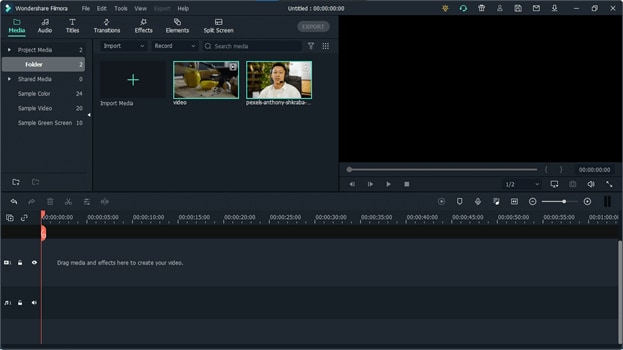
Step 03: Place both of these videos into the timeline. Make sure to place your reaction above.
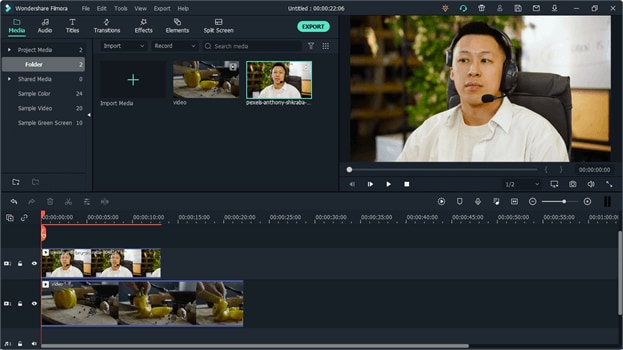
Step 04: Select your reaction video on the timeline and go to the “Effects”. Here you will find a new folder named “AI Portrait”, open it. Here you will find multiple AI portrait effects.
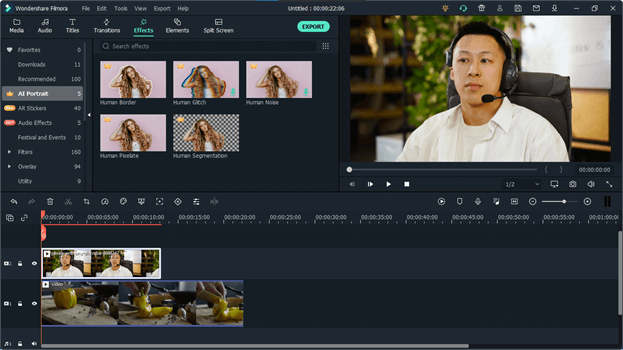
Step 05: Our goal is to remove the background of the reaction. To do that, we will use Human Segmentation. Drag and drop Human Segmentation into the reaction video. If you haven’t purchased this effect already, it will ask you to buy it to export the video. But you want to try it first, click on “Try It.”
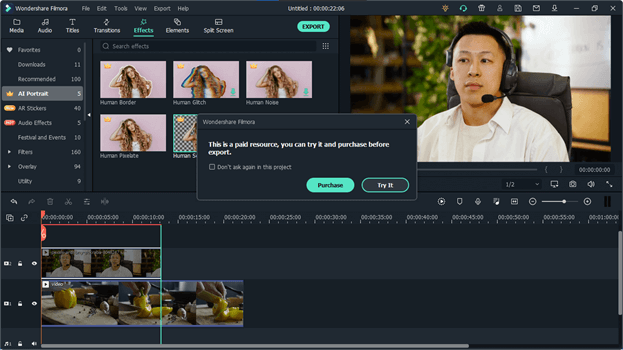
Step 06: Once the effect is successfully applied to the video, its background will be removed automatically.

Step 07: Adjust the video by making it smaller and place it in the bottom left corner of the screen. Your reaction video is ready to be uploaded on video-sharing platforms.
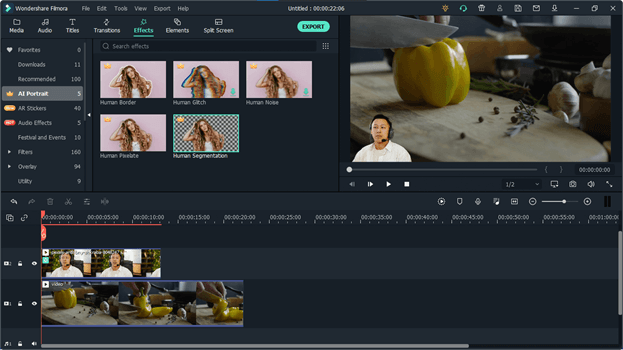
Step 08: To make your video look cool and stunning, you can also add multiple other effects to your reaction. AI portrait allows you to add a border around the character to make it look more visible and separate it from another video. Go to the AI portrait and drag Human Border Effect and drop it into your reaction. It will create an outline around the character and make it look more visible.
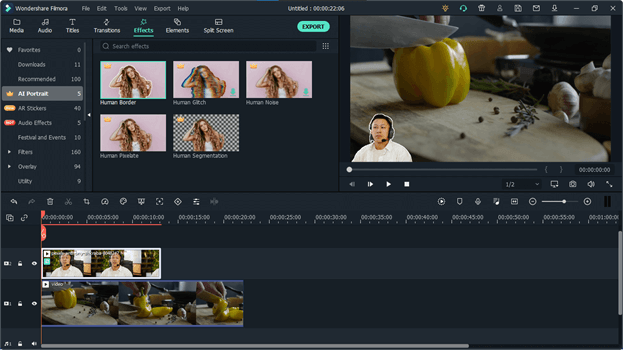
Step 09: In some instances, you might need to change the position or size of your reaction. You can easily do that by applying the Keyframes to it. If you feel like changing the part of your reaction at some point in the video, go to that point in the timeline and click on the keyframe button above the timeline.
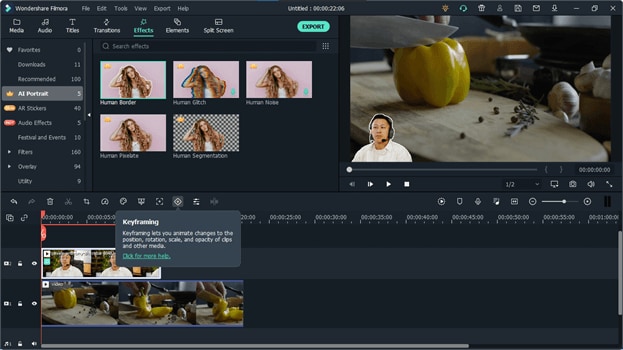
Step 10: Once you click on the keyframe, it will add a keyframe to the video. Now move forward into the timeline to a point and adjust your character’s position by dragging it. Let’s move it to the bottom right corner. It will add another keyframe to the video in the timeline. Now the character will change its position from the left corner to the right corner once it reaches that specific point in time.
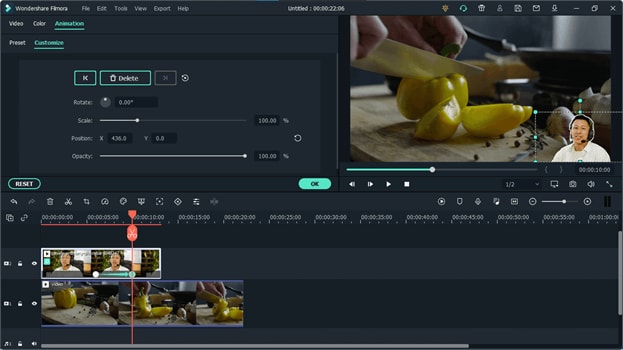
Conclusion
AI Portrait allows you to create wonderful effects using artificial intelligence. This is one of the best uses of AI to make stunning reaction videos. It will not only save you a lot of time but will also help you save a lot of money by helping you remove the background of your video without expensive materials such as a green screen and other materials related to it.

Liza Brown
Liza Brown is a writer and a lover of all things video.
Follow @Liza Brown
Liza Brown
Mar 27, 2024• Proven solutions
With several video-sharing platforms and billions of videos on those platforms, it is very difficult and competitive to make your mark and have an identity. There are hundreds of categories of videos that you can find on the platforms like Youtube, Dailymotion, Vimeo, and more. Among all those categories, reaction videos are one of the most popular categories. It allows a person to review another person’s opinion, view, or idea about any particular issue or instance. Most of the video-sharing platforms enable their users to make all kinds of reaction videos without any restriction. Having such a huge competition makes it hard to stand out and attract viewers.
Have you ever seen videos where the reactor has a transparent background instead of the rectangle box in the corner? They look nice and engaging, right? The process of making such videos will require so many materials such as a green screen, stand, and other materials to support it. It is difficult for everyone to afford all these and secondly, it is very difficult to carry from one place to another.
With Filmora X, you can create such transparent background reaction videos without such expensive material. Filmora has launched a new feature name AI Portrait that uses artificial intelligence to create amazing and cool effects. It uses the latest technology to separate the background and humans in the footage to help you remove the background with a single click. So, let’s get started with the process of making stunning reaction videos with Filmora’s AI Portrait.
You might be interested in:
Step 01: Open Filmora X. If it is not already installed on your PC, you can download it from here and install it on your PC.

Step 02: Import the video that you want to react to and your reaction video. If you have not already recorded your reaction, then record it first using any camera or smartphone.

Step 03: Place both of these videos into the timeline. Make sure to place your reaction above.

Step 04: Select your reaction video on the timeline and go to the “Effects”. Here you will find a new folder named “AI Portrait”, open it. Here you will find multiple AI portrait effects.

Step 05: Our goal is to remove the background of the reaction. To do that, we will use Human Segmentation. Drag and drop Human Segmentation into the reaction video. If you haven’t purchased this effect already, it will ask you to buy it to export the video. But you want to try it first, click on “Try It.”

Step 06: Once the effect is successfully applied to the video, its background will be removed automatically.

Step 07: Adjust the video by making it smaller and place it in the bottom left corner of the screen. Your reaction video is ready to be uploaded on video-sharing platforms.

Step 08: To make your video look cool and stunning, you can also add multiple other effects to your reaction. AI portrait allows you to add a border around the character to make it look more visible and separate it from another video. Go to the AI portrait and drag Human Border Effect and drop it into your reaction. It will create an outline around the character and make it look more visible.

Step 09: In some instances, you might need to change the position or size of your reaction. You can easily do that by applying the Keyframes to it. If you feel like changing the part of your reaction at some point in the video, go to that point in the timeline and click on the keyframe button above the timeline.

Step 10: Once you click on the keyframe, it will add a keyframe to the video. Now move forward into the timeline to a point and adjust your character’s position by dragging it. Let’s move it to the bottom right corner. It will add another keyframe to the video in the timeline. Now the character will change its position from the left corner to the right corner once it reaches that specific point in time.

Conclusion
AI Portrait allows you to create wonderful effects using artificial intelligence. This is one of the best uses of AI to make stunning reaction videos. It will not only save you a lot of time but will also help you save a lot of money by helping you remove the background of your video without expensive materials such as a green screen and other materials related to it.

Liza Brown
Liza Brown is a writer and a lover of all things video.
Follow @Liza Brown
Liza Brown
Mar 27, 2024• Proven solutions
With several video-sharing platforms and billions of videos on those platforms, it is very difficult and competitive to make your mark and have an identity. There are hundreds of categories of videos that you can find on the platforms like Youtube, Dailymotion, Vimeo, and more. Among all those categories, reaction videos are one of the most popular categories. It allows a person to review another person’s opinion, view, or idea about any particular issue or instance. Most of the video-sharing platforms enable their users to make all kinds of reaction videos without any restriction. Having such a huge competition makes it hard to stand out and attract viewers.
Have you ever seen videos where the reactor has a transparent background instead of the rectangle box in the corner? They look nice and engaging, right? The process of making such videos will require so many materials such as a green screen, stand, and other materials to support it. It is difficult for everyone to afford all these and secondly, it is very difficult to carry from one place to another.
With Filmora X, you can create such transparent background reaction videos without such expensive material. Filmora has launched a new feature name AI Portrait that uses artificial intelligence to create amazing and cool effects. It uses the latest technology to separate the background and humans in the footage to help you remove the background with a single click. So, let’s get started with the process of making stunning reaction videos with Filmora’s AI Portrait.
You might be interested in:
Step 01: Open Filmora X. If it is not already installed on your PC, you can download it from here and install it on your PC.

Step 02: Import the video that you want to react to and your reaction video. If you have not already recorded your reaction, then record it first using any camera or smartphone.

Step 03: Place both of these videos into the timeline. Make sure to place your reaction above.

Step 04: Select your reaction video on the timeline and go to the “Effects”. Here you will find a new folder named “AI Portrait”, open it. Here you will find multiple AI portrait effects.

Step 05: Our goal is to remove the background of the reaction. To do that, we will use Human Segmentation. Drag and drop Human Segmentation into the reaction video. If you haven’t purchased this effect already, it will ask you to buy it to export the video. But you want to try it first, click on “Try It.”

Step 06: Once the effect is successfully applied to the video, its background will be removed automatically.

Step 07: Adjust the video by making it smaller and place it in the bottom left corner of the screen. Your reaction video is ready to be uploaded on video-sharing platforms.

Step 08: To make your video look cool and stunning, you can also add multiple other effects to your reaction. AI portrait allows you to add a border around the character to make it look more visible and separate it from another video. Go to the AI portrait and drag Human Border Effect and drop it into your reaction. It will create an outline around the character and make it look more visible.

Step 09: In some instances, you might need to change the position or size of your reaction. You can easily do that by applying the Keyframes to it. If you feel like changing the part of your reaction at some point in the video, go to that point in the timeline and click on the keyframe button above the timeline.

Step 10: Once you click on the keyframe, it will add a keyframe to the video. Now move forward into the timeline to a point and adjust your character’s position by dragging it. Let’s move it to the bottom right corner. It will add another keyframe to the video in the timeline. Now the character will change its position from the left corner to the right corner once it reaches that specific point in time.

Conclusion
AI Portrait allows you to create wonderful effects using artificial intelligence. This is one of the best uses of AI to make stunning reaction videos. It will not only save you a lot of time but will also help you save a lot of money by helping you remove the background of your video without expensive materials such as a green screen and other materials related to it.

Liza Brown
Liza Brown is a writer and a lover of all things video.
Follow @Liza Brown
Liza Brown
Mar 27, 2024• Proven solutions
With several video-sharing platforms and billions of videos on those platforms, it is very difficult and competitive to make your mark and have an identity. There are hundreds of categories of videos that you can find on the platforms like Youtube, Dailymotion, Vimeo, and more. Among all those categories, reaction videos are one of the most popular categories. It allows a person to review another person’s opinion, view, or idea about any particular issue or instance. Most of the video-sharing platforms enable their users to make all kinds of reaction videos without any restriction. Having such a huge competition makes it hard to stand out and attract viewers.
Have you ever seen videos where the reactor has a transparent background instead of the rectangle box in the corner? They look nice and engaging, right? The process of making such videos will require so many materials such as a green screen, stand, and other materials to support it. It is difficult for everyone to afford all these and secondly, it is very difficult to carry from one place to another.
With Filmora X, you can create such transparent background reaction videos without such expensive material. Filmora has launched a new feature name AI Portrait that uses artificial intelligence to create amazing and cool effects. It uses the latest technology to separate the background and humans in the footage to help you remove the background with a single click. So, let’s get started with the process of making stunning reaction videos with Filmora’s AI Portrait.
You might be interested in:
Step 01: Open Filmora X. If it is not already installed on your PC, you can download it from here and install it on your PC.

Step 02: Import the video that you want to react to and your reaction video. If you have not already recorded your reaction, then record it first using any camera or smartphone.

Step 03: Place both of these videos into the timeline. Make sure to place your reaction above.

Step 04: Select your reaction video on the timeline and go to the “Effects”. Here you will find a new folder named “AI Portrait”, open it. Here you will find multiple AI portrait effects.

Step 05: Our goal is to remove the background of the reaction. To do that, we will use Human Segmentation. Drag and drop Human Segmentation into the reaction video. If you haven’t purchased this effect already, it will ask you to buy it to export the video. But you want to try it first, click on “Try It.”

Step 06: Once the effect is successfully applied to the video, its background will be removed automatically.

Step 07: Adjust the video by making it smaller and place it in the bottom left corner of the screen. Your reaction video is ready to be uploaded on video-sharing platforms.

Step 08: To make your video look cool and stunning, you can also add multiple other effects to your reaction. AI portrait allows you to add a border around the character to make it look more visible and separate it from another video. Go to the AI portrait and drag Human Border Effect and drop it into your reaction. It will create an outline around the character and make it look more visible.

Step 09: In some instances, you might need to change the position or size of your reaction. You can easily do that by applying the Keyframes to it. If you feel like changing the part of your reaction at some point in the video, go to that point in the timeline and click on the keyframe button above the timeline.

Step 10: Once you click on the keyframe, it will add a keyframe to the video. Now move forward into the timeline to a point and adjust your character’s position by dragging it. Let’s move it to the bottom right corner. It will add another keyframe to the video in the timeline. Now the character will change its position from the left corner to the right corner once it reaches that specific point in time.

Conclusion
AI Portrait allows you to create wonderful effects using artificial intelligence. This is one of the best uses of AI to make stunning reaction videos. It will not only save you a lot of time but will also help you save a lot of money by helping you remove the background of your video without expensive materials such as a green screen and other materials related to it.

Liza Brown
Liza Brown is a writer and a lover of all things video.
Follow @Liza Brown
From Motion to Still: A Simple Guide to Freezing Frames
How to Freeze Frame in a Video Easily

Liza Brown
Mar 27, 2024• Proven solutions
Want to make a still or “Frozen” scene to tell the most exciting or the funniest moment of the story? Or would like to freeze something to give a familiar story some freshness? Actually, it’s quite easy to freeze a video to emphasis an action or add some captions if you get the right tool at hand.
Here, Wondershare Filmora is directly shared with you. With it, you can create a still image with your desired zoom in and out effect in a simple click. Below shows how to do it step by step.
To begin with, get a free trial copy of Wondershare Filmora.
 Download Mac Version ](https://tools.techidaily.com/wondershare/filmora/download/ )
Download Mac Version ](https://tools.techidaily.com/wondershare/filmora/download/ )
Why You Need to Freeze Frame in a Video
You can show your favorite scene by freezing a video to let viewers know your idea easily. In doing so, the core of your video would be shown naturally. After you apply freeze video, your video will be split into two parts because the edited frame will be in the middle of the clicp. However, it won’t affect the completeness of video. Safe and easy!
You may also like: How to Edit Video Frame
How to Freeze Video with Filmora
1 Import your media files
Click “Import” to browse your file folder or simply drag and drop all files into the primary window. This program supports a vast array of media files, including WMV, MOV, MP4, AVI, MKV, MTS, DV, TS, 3GP, M4V, and more.
When you load all of them, they will show as thumbnails in the Media Library. Now drag them to the Video Timeline and get ready for step 2.
Note: by default, all files in Video Timeline will be merged together without any stop.
You may also like: How to Create Freeze Frame in Adobe Premiere Pro

2 Freeze video with ease
Now play the video clip you want to create a frozen picture, and pause it when it comes to the right position. Click the “Snapshot” incon that locates under the Viewer panel. Immediately, there will be a picture added to media library. Drag the image to the PIP track over the main video track, and set the duration of the still image.
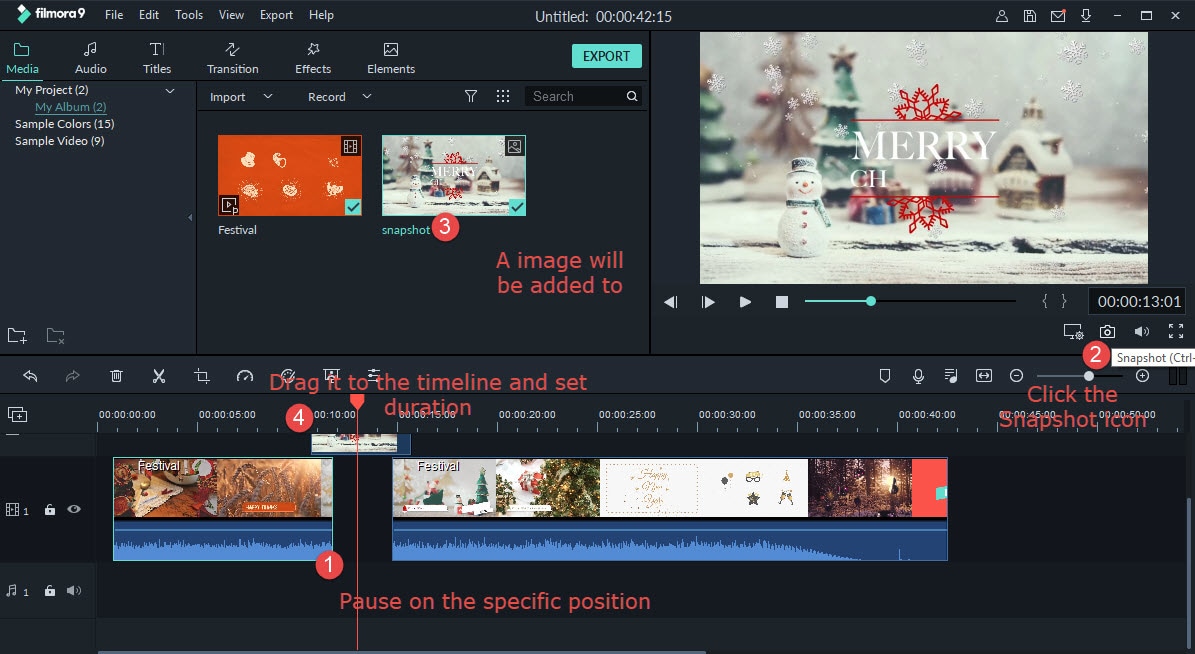
Now you’ve created a frozen frame, want to further customize it? Double click the picture icon to reveal the editing window. Here, you can rotate it 90 degrees clockwise, adjust the duration, brightness, contrast.
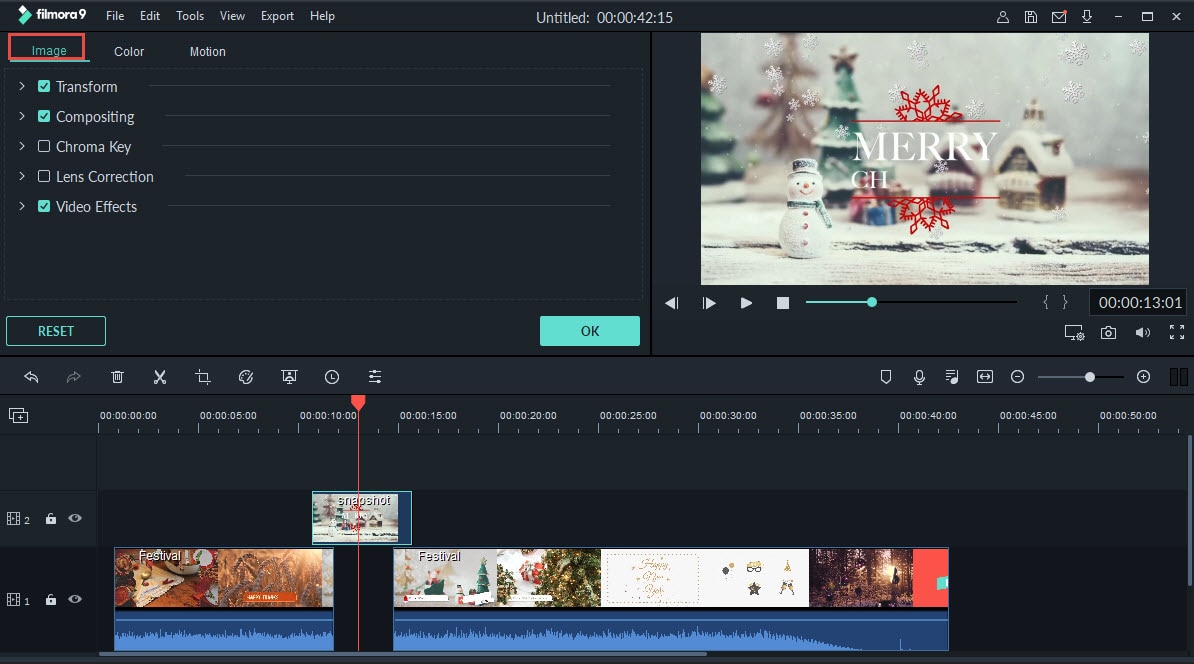
You can also pick up your favorite fade in/out or zoom in/out effect by in the “Motion” pane.

3 Save your creation
When everything satisfies, simply click “Export” to export your creation. In the pop-up window that appears, choose from a variety of format options to save onto your computer. Or directly upload it to YouTube, Facebook, Twitter to share with your friends or family.
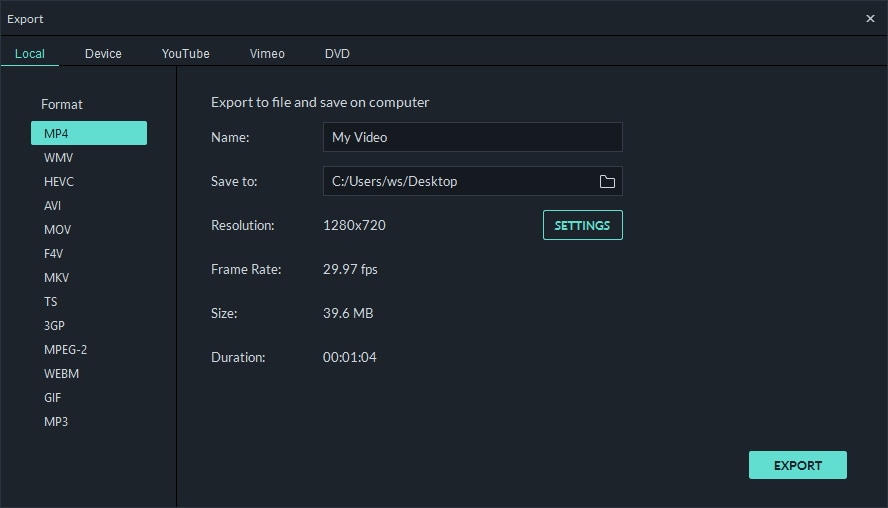
Bonus tips:
You may also want to add captions for the still image to make it more meaningful. It’s pretty easy to do this with the help of Wondershare Filmora . Simply click the “Text/Credit” tab in the toolbar, and pick up your favorite template to further customize it. Time duration, size, and zoom in/out effect are all flexibly adjustable.
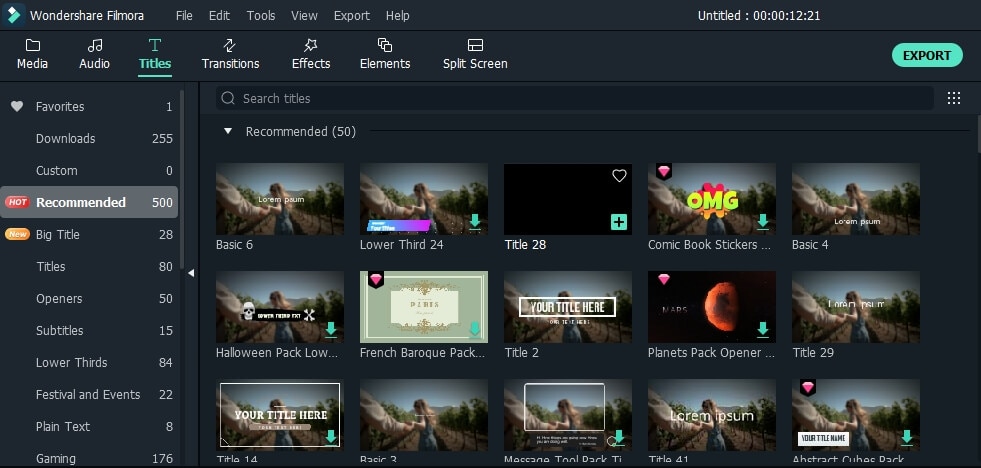
 Download Mac Version ](https://tools.techidaily.com/wondershare/filmora/download/ )
Download Mac Version ](https://tools.techidaily.com/wondershare/filmora/download/ )

Liza Brown
Liza Brown is a writer and a lover of all things video.
Follow @Liza Brown
Liza Brown
Mar 27, 2024• Proven solutions
Want to make a still or “Frozen” scene to tell the most exciting or the funniest moment of the story? Or would like to freeze something to give a familiar story some freshness? Actually, it’s quite easy to freeze a video to emphasis an action or add some captions if you get the right tool at hand.
Here, Wondershare Filmora is directly shared with you. With it, you can create a still image with your desired zoom in and out effect in a simple click. Below shows how to do it step by step.
To begin with, get a free trial copy of Wondershare Filmora.
 Download Mac Version ](https://tools.techidaily.com/wondershare/filmora/download/ )
Download Mac Version ](https://tools.techidaily.com/wondershare/filmora/download/ )
Why You Need to Freeze Frame in a Video
You can show your favorite scene by freezing a video to let viewers know your idea easily. In doing so, the core of your video would be shown naturally. After you apply freeze video, your video will be split into two parts because the edited frame will be in the middle of the clicp. However, it won’t affect the completeness of video. Safe and easy!
You may also like: How to Edit Video Frame
How to Freeze Video with Filmora
1 Import your media files
Click “Import” to browse your file folder or simply drag and drop all files into the primary window. This program supports a vast array of media files, including WMV, MOV, MP4, AVI, MKV, MTS, DV, TS, 3GP, M4V, and more.
When you load all of them, they will show as thumbnails in the Media Library. Now drag them to the Video Timeline and get ready for step 2.
Note: by default, all files in Video Timeline will be merged together without any stop.
You may also like: How to Create Freeze Frame in Adobe Premiere Pro

2 Freeze video with ease
Now play the video clip you want to create a frozen picture, and pause it when it comes to the right position. Click the “Snapshot” incon that locates under the Viewer panel. Immediately, there will be a picture added to media library. Drag the image to the PIP track over the main video track, and set the duration of the still image.

Now you’ve created a frozen frame, want to further customize it? Double click the picture icon to reveal the editing window. Here, you can rotate it 90 degrees clockwise, adjust the duration, brightness, contrast.

You can also pick up your favorite fade in/out or zoom in/out effect by in the “Motion” pane.

3 Save your creation
When everything satisfies, simply click “Export” to export your creation. In the pop-up window that appears, choose from a variety of format options to save onto your computer. Or directly upload it to YouTube, Facebook, Twitter to share with your friends or family.

Bonus tips:
You may also want to add captions for the still image to make it more meaningful. It’s pretty easy to do this with the help of Wondershare Filmora . Simply click the “Text/Credit” tab in the toolbar, and pick up your favorite template to further customize it. Time duration, size, and zoom in/out effect are all flexibly adjustable.

 Download Mac Version ](https://tools.techidaily.com/wondershare/filmora/download/ )
Download Mac Version ](https://tools.techidaily.com/wondershare/filmora/download/ )

Liza Brown
Liza Brown is a writer and a lover of all things video.
Follow @Liza Brown
Liza Brown
Mar 27, 2024• Proven solutions
Want to make a still or “Frozen” scene to tell the most exciting or the funniest moment of the story? Or would like to freeze something to give a familiar story some freshness? Actually, it’s quite easy to freeze a video to emphasis an action or add some captions if you get the right tool at hand.
Here, Wondershare Filmora is directly shared with you. With it, you can create a still image with your desired zoom in and out effect in a simple click. Below shows how to do it step by step.
To begin with, get a free trial copy of Wondershare Filmora.
 Download Mac Version ](https://tools.techidaily.com/wondershare/filmora/download/ )
Download Mac Version ](https://tools.techidaily.com/wondershare/filmora/download/ )
Why You Need to Freeze Frame in a Video
You can show your favorite scene by freezing a video to let viewers know your idea easily. In doing so, the core of your video would be shown naturally. After you apply freeze video, your video will be split into two parts because the edited frame will be in the middle of the clicp. However, it won’t affect the completeness of video. Safe and easy!
You may also like: How to Edit Video Frame
How to Freeze Video with Filmora
1 Import your media files
Click “Import” to browse your file folder or simply drag and drop all files into the primary window. This program supports a vast array of media files, including WMV, MOV, MP4, AVI, MKV, MTS, DV, TS, 3GP, M4V, and more.
When you load all of them, they will show as thumbnails in the Media Library. Now drag them to the Video Timeline and get ready for step 2.
Note: by default, all files in Video Timeline will be merged together without any stop.
You may also like: How to Create Freeze Frame in Adobe Premiere Pro

2 Freeze video with ease
Now play the video clip you want to create a frozen picture, and pause it when it comes to the right position. Click the “Snapshot” incon that locates under the Viewer panel. Immediately, there will be a picture added to media library. Drag the image to the PIP track over the main video track, and set the duration of the still image.

Now you’ve created a frozen frame, want to further customize it? Double click the picture icon to reveal the editing window. Here, you can rotate it 90 degrees clockwise, adjust the duration, brightness, contrast.

You can also pick up your favorite fade in/out or zoom in/out effect by in the “Motion” pane.

3 Save your creation
When everything satisfies, simply click “Export” to export your creation. In the pop-up window that appears, choose from a variety of format options to save onto your computer. Or directly upload it to YouTube, Facebook, Twitter to share with your friends or family.

Bonus tips:
You may also want to add captions for the still image to make it more meaningful. It’s pretty easy to do this with the help of Wondershare Filmora . Simply click the “Text/Credit” tab in the toolbar, and pick up your favorite template to further customize it. Time duration, size, and zoom in/out effect are all flexibly adjustable.

 Download Mac Version ](https://tools.techidaily.com/wondershare/filmora/download/ )
Download Mac Version ](https://tools.techidaily.com/wondershare/filmora/download/ )

Liza Brown
Liza Brown is a writer and a lover of all things video.
Follow @Liza Brown
Liza Brown
Mar 27, 2024• Proven solutions
Want to make a still or “Frozen” scene to tell the most exciting or the funniest moment of the story? Or would like to freeze something to give a familiar story some freshness? Actually, it’s quite easy to freeze a video to emphasis an action or add some captions if you get the right tool at hand.
Here, Wondershare Filmora is directly shared with you. With it, you can create a still image with your desired zoom in and out effect in a simple click. Below shows how to do it step by step.
To begin with, get a free trial copy of Wondershare Filmora.
 Download Mac Version ](https://tools.techidaily.com/wondershare/filmora/download/ )
Download Mac Version ](https://tools.techidaily.com/wondershare/filmora/download/ )
Why You Need to Freeze Frame in a Video
You can show your favorite scene by freezing a video to let viewers know your idea easily. In doing so, the core of your video would be shown naturally. After you apply freeze video, your video will be split into two parts because the edited frame will be in the middle of the clicp. However, it won’t affect the completeness of video. Safe and easy!
You may also like: How to Edit Video Frame
How to Freeze Video with Filmora
1 Import your media files
Click “Import” to browse your file folder or simply drag and drop all files into the primary window. This program supports a vast array of media files, including WMV, MOV, MP4, AVI, MKV, MTS, DV, TS, 3GP, M4V, and more.
When you load all of them, they will show as thumbnails in the Media Library. Now drag them to the Video Timeline and get ready for step 2.
Note: by default, all files in Video Timeline will be merged together without any stop.
You may also like: How to Create Freeze Frame in Adobe Premiere Pro

2 Freeze video with ease
Now play the video clip you want to create a frozen picture, and pause it when it comes to the right position. Click the “Snapshot” incon that locates under the Viewer panel. Immediately, there will be a picture added to media library. Drag the image to the PIP track over the main video track, and set the duration of the still image.

Now you’ve created a frozen frame, want to further customize it? Double click the picture icon to reveal the editing window. Here, you can rotate it 90 degrees clockwise, adjust the duration, brightness, contrast.

You can also pick up your favorite fade in/out or zoom in/out effect by in the “Motion” pane.

3 Save your creation
When everything satisfies, simply click “Export” to export your creation. In the pop-up window that appears, choose from a variety of format options to save onto your computer. Or directly upload it to YouTube, Facebook, Twitter to share with your friends or family.

Bonus tips:
You may also want to add captions for the still image to make it more meaningful. It’s pretty easy to do this with the help of Wondershare Filmora . Simply click the “Text/Credit” tab in the toolbar, and pick up your favorite template to further customize it. Time duration, size, and zoom in/out effect are all flexibly adjustable.

 Download Mac Version ](https://tools.techidaily.com/wondershare/filmora/download/ )
Download Mac Version ](https://tools.techidaily.com/wondershare/filmora/download/ )

Liza Brown
Liza Brown is a writer and a lover of all things video.
Follow @Liza Brown
Also read:
- New Top-Rated Free WMV Video Joiner Programs for 2024
- New In 2024, LinkedIn Video Mastery Choosing the Perfect Aspect Ratio
- Updated The Ultimate Guide to Virtualdub and Its Most Popular Alternatives
- Premiere Pro Compatibility What You Need to Know About System Requirements for 2024
- Updated 2024 Approved Windows Movie Maker Free Download A Comprehensive Guide
- Updated 2024 Approved The Ultimate Twitter Video Sizing Cheat Sheet Aspect Ratio Included
- 2024 Approved Whats My Aspect Ratio? Calculator and Tutorial
- Mastering Aspect Ratios in Final Cut Pro A Beginners Guide for 2024
- Updated The Best Free WMV Video Merging Solutions for 2024
- Updated In 2024, Slideshow Magic with Final Cut Pro Tips, Tricks, and Techniques
- 2024 Approved Maximizing Mobile Engagement Best Practices for Vertical Content
- Updated Ratio Mastery How to Calculate Pixels Like a Pro for 2024
- Updated In 2024, Video to Audio Conversion Made Easy My 5 Essential Selection Tips
- Updated Edit Videos Like a Pro 14 Free Software Options Without Watermarks for 2024
- Updated 2024 Approved Perfecting Your Facebook Video Cover Tips for Ideal Sizing
- Updated Hand-Drawn Whiteboard Animation Made Easy Top 5 Tools for 2024
- In 2024, Unleash Your Inner Filmmaker 8 Top Mac Video Editors
- Updated 2024 Approved From Idea to Screen Easy Film Production for Beginners
- New The Math Behind the Screen 5 Revealing Facts About 16X9 Calculators
- New Unlock Efficient Video Editing 6 Adobe Premiere Hacks You Need to Know for 2024
- Updated 2024 Approved Free Online Video Smoothers Our Top Picks
- In 2024, Trim Videos for Free 7 Watermark-Free Editors
- New In This Article, We Will Review Gopro Quik for Desktop and Recommend Alternatives to Gopro Quik Pc for 2024
- New Design Your Dream Collage Top Online Photo and Video Editors for 2024
- Updated Unleash the Power of Reverse How to Edit TikTok Videos Like a Pro
- New The Art of Cinematic Editing A Final Cut Pro X Tutorial
- New 2024 Approved Top iMovie Replacements for Windows 10 Free and Premium Options
- Updated In 2024, Capture Lifes Moments Best Time-Lapse Apps for iOS and Android
- Make Every Moment Epic A Guide to Slow-Motion Video Editing on Kapwing for 2024
- Updated In 2024, Vignette Perfection The Best Mobile Apps for Adding Frames and Borders
- Updated Make Your Own Cartoons Top 10 Mobile Video Editors for 2024
- New In 2024, Converting Music to Video What You Should Keep in Mind
- Updated In 2024, Androids Finest 10 Movie Making Apps You Need
- In 2024, The Ultimate Showdown Final Cut Pro Vs. Final Cut Express
- Videopad Video Editor Review Does It Live Up to the Hype, In 2024
- Updated The Art of the Ken Burns Effect Tips and Tricks for Stunning Results
- New Smooth Operator A Plugin-Free Guide to Skin Retouching in FCPX
- Updated 2024 Approved Jaycut 101 How to Edit Videos Online for Free
- Updated In 2024, In This Article, We Will Review AVS Video Editor and Discuss, Features It Has and How Good Avs Video Editor Is
- Updated 2024 Approved Video Editing Made Easy Top Free Software for 32-Bit Windows
- Updated In 2024, Official 4 Best Ways to Get Filmora Discount Codes
- New The Complete Guide to Video Editors Best Options for Windows, Mac, iOS, Android, and Linux
- Updated Top 10 Vlogging Apps for iOS and Android Devices
- In 2024, Motion Blur Magic A Comprehensive Guide to Final Cut Pro Techniques
- New 2024 Approved S Best Video Merging and Collage Apps for iPhone and iPad Users
- In 2024, Make Movies Like a Pro Insider Secrets for Achieving Professional Results
- Updated Transform Your Photos Into Captivating Videos on Mac OS for 2024
- Updated Color Perfection in Final Cut Pro 2023 Tips and Techniques for 2024
- Updated Legitimate Ways to Use Filmora Without Paying a Dime for 2024
- A Complete Guide To OEM Unlocking on Honor Magic V2
- Proven Ways to Fix There Was A Problem Parsing the Package on Xiaomi Civi 3 | Dr.fone
- Strategies for Apps That Wont Download From Play Store On Oppo A58 4G | Dr.fone
- How to Upgrade Apple iPhone 13 Pro without Losing Any Data? | Dr.fone
- How to Mirror PC Screen to Samsung Galaxy S23 Tactical Edition Phones? | Dr.fone
- How to Change Spotify Location After Moving to Another Country On Xiaomi 14 Ultra | Dr.fone
- Unlock a disable iPhone XS Max using macOS finder
- In 2024, 3 Facts You Need to Know about Screen Mirroring Xiaomi Redmi K70 | Dr.fone
- In 2024, Network Locked SIM Card Inserted On Your Motorola Moto G24 Phone? Unlock It Now
- Will the iPogo Get You Banned and How to Solve It On Oppo Find N3 | Dr.fone
- Top 10 Fixes for Phone Keep Disconnecting from Wi-Fi On Tecno Spark 10C | Dr.fone
- 5 Best Route Generator Apps You Should Try On Honor 90 | Dr.fone
- Trouble with Apple iPhone 13 mini Swipe-Up? Try These 11 Solutions | Dr.fone
- In 2024, How To Remove Screen Lock PIN On Infinix Hot 30i Like A Pro 5 Easy Ways
- Quickly Remove Google FRP Lock on Xiaomi Redmi K70
- In 2024, Disabled iPhone 15 How to Unlock a Disabled iPhone 15?
- How to Exit Android Factory Mode On Vivo V30 Lite 5G? | Dr.fone
- 2024 Approved Top 4 Hatsune Miku Voice AI Generators for All Times
- In 2024, How to Track WhatsApp Messages on Xiaomi Redmi A2+ Without Them Knowing? | Dr.fone
- In 2024, Make Well Done Animated GIF
- 4 Easy Ways for Your Xiaomi 14 Hard Reset | Dr.fone
- In 2024, The Best Android SIM Unlock Code Generators Unlock Your Vivo T2x 5G Phone Hassle-Free
- In 2024, 2 Ways to Transfer Text Messages from Vivo G2 to iPhone 15/14/13/12/11/X/8/ | Dr.fone
- In 2024, Hassle-Free Ways to Remove FRP Lock from Nokia C22 Phones with/without a PC
- In 2024, How to Transfer Contacts from Infinix Note 30 VIP Racing Edition to iPhone XS/11 | Dr.fone
- New A Complete Guide To Translate Video With Google
- In 2024, How to Transfer Data from Realme C33 2023 to Other Android Devices? | Dr.fone
- In 2024, iPhone 7 Plus Backup Password Never Set But Still Asking? Heres the Fix
- What are Location Permissions Life360 On Itel A60s? | Dr.fone
- How to Fix Android App Not Installed Error on Vivo T2 Pro 5G Quickly? | Dr.fone
- Full Guide How To Fix Connection Is Not Private on Samsung Galaxy M34 5G | Dr.fone
- In 2024, Your Account Has Been Disabled in the App Store and iTunes From Apple iPhone 11 Pro?
- Title: New Final Cut Pro Tutorial Adding Picture-in-Picture Effects to Your Videos for 2024
- Author: MdadeLe
- Created at : 2024-05-19 08:28:42
- Updated at : 2024-05-20 08:28:42
- Link: https://smart-video-editing.techidaily.com/new-final-cut-pro-tutorial-adding-picture-in-picture-effects-to-your-videos-for-2024/
- License: This work is licensed under CC BY-NC-SA 4.0.


